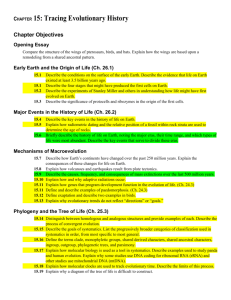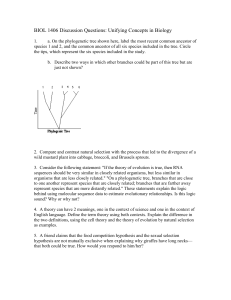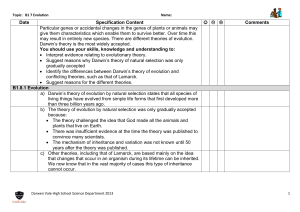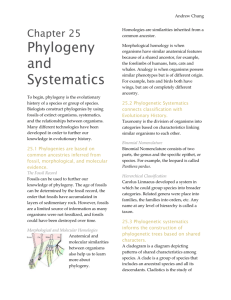Chapter 15
advertisement
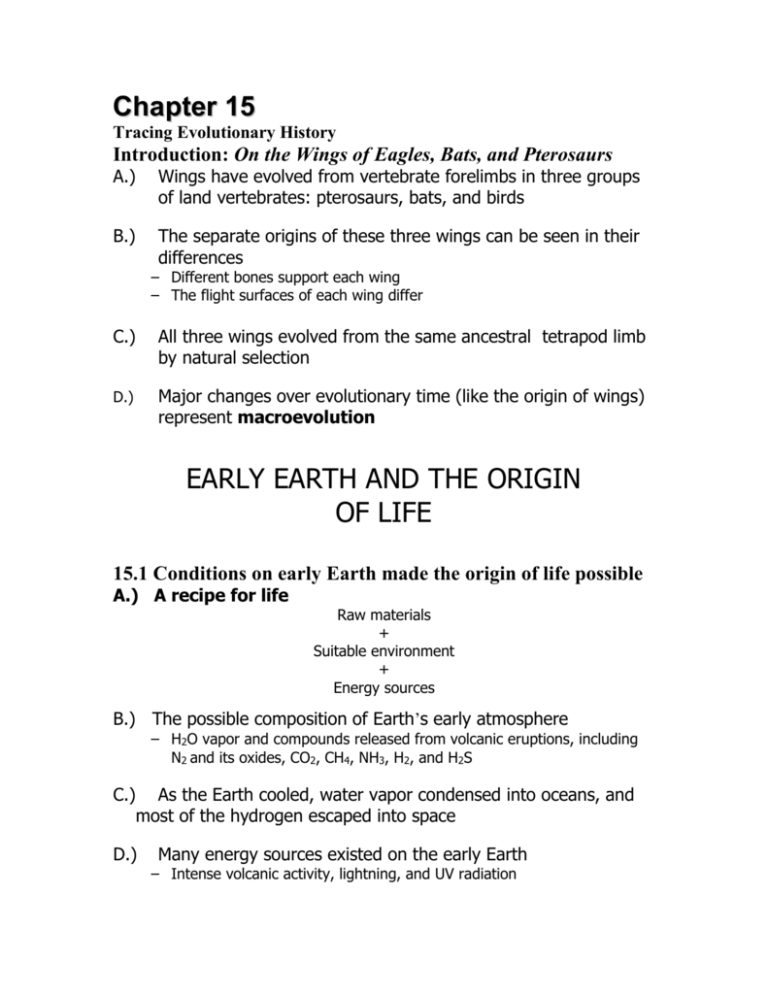
Chapter 15 Tracing Evolutionary History Introduction: On the Wings of Eagles, Bats, and Pterosaurs A.) Wings have evolved from vertebrate forelimbs in three groups of land vertebrates: pterosaurs, bats, and birds B.) The separate origins of these three wings can be seen in their differences – Different bones support each wing – The flight surfaces of each wing differ C.) All three wings evolved from the same ancestral tetrapod limb by natural selection D.) Major changes over evolutionary time (like the origin of wings) represent macroevolution EARLY EARTH AND THE ORIGIN OF LIFE 15.1 Conditions on early Earth made the origin of life possible A.) A recipe for life Raw materials + Suitable environment + Energy sources B.) The possible composition of Earth’s early atmosphere – H2O vapor and compounds released from volcanic eruptions, including N2 and its oxides, CO2, CH4, NH3, H2, and H2S C.) As the Earth cooled, water vapor condensed into oceans, and most of the hydrogen escaped into space D.) Many energy sources existed on the early Earth – Intense volcanic activity, lightning, and UV radiation E.) Earth formed 4.6 billion years ago F.) By 3.5 billion years ago, photosynthetic bacteria formed sandy stromatolite mats G.) The first living things were much simpler and arose much earlier 15.2 TALKING ABOUT SCIENCE: Stanley Miller’s experiments showed that the abiotic synthesis of organic molecules is possible A.) In the 1920s, two scientists—the Russian A. I. Oparin and the British J. B. S. Haldane—independently proposed that organic molecules could have formed on the early Earth B.) Modern atmosphere is rich in O2, which oxidizes and disrupts chemical bonds C.) The early Earth likely had a reducing atmosphere D.) In 1953, graduate student Stanley Miller tested the OparinHaldane hypothesis – Miller set up an airtight apparatus with gases circulating past an electrical discharge, to simulate conditions on the early Earth – He also set up a control with no electrical discharge – Why? E.) After a week, Miller’s setup produced abundant amino acids and other organic molecules – Similar experiments used other atmospheres and other energy sources, with similar results – Miller-Urey experiments demonstrate that Stage 1, abiotic synthesis of organic molecules, was possible on the early Earth F.) An alternative hypothesis – Submerged volcanoes and deep-sea hydrothermal vents may have provided the chemical resources for the first life 15.3 The formation of polymers, membranes, and selfreplicating molecules represent stages in the origin of the A.) B.) first cells Stage 2: The formation of polymers – Monomers could have combined to form organic polymers – Same energy sources – Clay as substratum for polymerization? Stage 2: Packaging of polymers into protobionts – Polymers could have aggregated into complex, organized, cell-like structures C.) What characteristics do cells and protobionts share? – – – – Structural organization Simple reproduction Simple metabolism Simple homeostasis Which came first? D.) – Life requires the maintenance of a complex, stable, internal environment – What provides this in modern cells? – Life requires accurate self replication – What provides this in modern cells? E.) Stage 4: Self-replication – RNA may have served both as the first genetic material and as the first enzymes – The first genes may have been short strands of RNA that replicated without protein support – RNA catalysts or ribozymes may have assisted in this process. RNA world! F.) A variety of protobionts existed on the early Earth G.) Some of these protobionts contained self-replicating RNA molecules How could natural selection have acted on these protobionts? MAJOR EVENTS IN THE HISTORY OF LIFE 15.4 The origins of single-celled and multicelled organisms and the colonization of land are key events in life’s history A.) Three eons – Archaean and Proterozoic lasted 4 billion years – Phanerozoic is the last ½ billion years – Divided into Paleozoic era, Mesozoic era, Cenozoic era B.) Prokaryotes lived alone on Earth for 1.5 billion years – They created our atmosphere and transformed Earth’s biosphere C.) Virtually all metabolic pathways evolved within prokaryotes – Atmospheric oxygen appeared 2.7 billion years ago due to prokaryotic photosynthesis – Cellular respiration arose in prokaryotes, using oxygen to harvest energy from organic molecules D.) The eukaryotic cell probably originated as a community of prokaryotes, when small prokaryotes capable of aerobic respiration or photosynthesis began living in larger cells – Oldest fossils of eukaryotes are 2.1 billion years old E.) Multicellular forms arose about 1.5 billion years ago – The descendents of these forms include a variety of algae, plants, fungi, animals F.) The oldest known fossils of multicellular organisms were small algae, living 1.2 billion years ago G.) The diversity of animal forms increased suddenly and dramatically about 535–525 million years ago in the Cambrian explosion H.) I.) J.) Fungi and plants colonized land together 500 million years ago – Roots of most plants have fungal associates that exchange water and minerals for nutrients Arthropods and tetrapods are the most widespread and diverse land animals Human lineage diverged from apes 7–6 million years ago – Our species originated 160,000 years ago 15.5 The actual ages of rocks and fossils mark geologic time A.) Radiometric dating measures the decay of radioactive isotopes B.) “Young” fossils may contain isotopes of elements that accumulated when the organisms were alive C.) – Carbon-14 can date fossils up to 75,000 years old Potassium-40, with a half-life of 1.3 billion years, can be used to date volcanic rocks that are hundreds of millions of years old – A fossil’s age can be inferred from the ages of the rock layers above and below the strata in which the fossil is found 15.6 The fossil record documents the history of life A.) The fossil record documents the main events in the history of life B.) The geologic record is defined by major transitions in life on Earth MECHANISMS OF MACROEVOLUTION 15.7 Continental drift has played a major role in macroevolution A.) Continental drift is the slow, continuous movement of Earth’s crustal plates on the hot mantle – Crustal plates carrying continents and seafloors float on a liquid mantle B.) C.) Important geologic processes occur at plate boundaries – Sliding plates are earthquake zones – Colliding plates form mountains The supercontinent Pangaea, which formed 250 million years ago, altered habitats and triggered the greatest mass extinction in Earth’s history – Its breakup led to the modern arrangement of continents – Australia’s marsupials became isolated when the continents separated, and placental mammals arose on other continents – India’s collision with Eurasia 55 million years ago led to the formation of the Himalayas 15.8 CONNECTION: The effects of continental drift may imperil human life A.) Volcanoes and earthquakes result from the movements of crustal plates – The boundaries of plates are hotspots of volcanic and earthquake activity – An undersea earthquake caused the 2004 tsunami, when a fault in the Indian Ocean ruptured 15.9 Mass extinctions destroy large numbers of species A.) Extinction is the fate of all species and most lineages B.) The history of life on Earth reflects a steady background extinction rate with episodes of mass extinction C.) Over the last 600 million years, five mass extinctions have occurred in which 50% or more of the Earth’s species went extinct D.) Permian extinction – 96% of shallow water marine species died in the Permian extinction – Possible cause? – Extreme vulcanism in Siberia released CO2, warmed global climate, slowed mixing of ocean water, and reduced O2 availability in the ocean E.) Cretaceous extinction – 50% of marine species and many terrestrial lineages went extinct 65 million years ago – All dinosaurs (except birds) went extinct – Likely cause was a large asteroid that struck the Earth, blocking light and disrupting the global climate F.) It took 100 million years for the number of marine families to recover after Permian mass extinction G.) Is a 6th extinction under way? – The current extinction rate is 100–1,000 times the normal background rate – It may take life on Earth millions of years to recover 15.10 EVOLUTION CONNECTION: Adaptive radiations have increased the diversity of life A.) Adaptive radiation: a group of organisms forms new species, whose adaptations allow them to fill new habitats or roles in their communities B.) A rebound in diversity follows mass extinctions as survivors become adapted to vacant ecological niches – Mammals underwent a dramatic adaptive radiation after the extinction of nonavian dinosaurs 65 million years ago C.) Adaptive radiations may follow the evolution of new adaptations, such as wings – Radiations of land plants were associated with many novel features, including waxy coat, vascular tissue, seeds, and flowers 15.11 Genes that control development play a major role in evolution A.) “Evo-devo” is a field that combines evolutionary and developmental biology B.) Slight genetic changes can lead to major morphological differences between species – Changes in genes that alter the timing, rate, and spatial pattern of growth alter the adult form of an organism C.) Many developmental genes have been conserved throughout evolutionary history – Changes in these genes have led to the huge diversity in body forms D.) Human development is paedomorphic, retaining juvenile traits into adulthood – Adult chimps have massive, projecting jaws; large teeth; and a low forehead with a small braincase – Human adults—and both human and chimpanzee fetuses—lack these features – Humans and chimpanzees are more alike as fetuses than as adults E.) The human brain continues to grow at the fetal rate for the first year of life F.) Homeotic genes are master control genes that determine basic features, such as where pairs of wings or legs develop on a fruit fly G.) Developing fish and tetrapod limbs express certain homeotic genes – A second region of expression in the developing tetrapod limb produces the extra skeletal elements that form feet, turning fins into walking legs H.) Duplication of developmental genes can be important in the formation of new morphological features I.) A fruit fly has a single cluster of homeotic genes; a mouse has four – Two duplications of these gene clusters in evolution from invertebrates into vertebrates – Mutations in these duplicated genes may have led to the origin of novel vertebrate characteristics, including backbone, jaws, and limbs 15.12 Evolutionary novelties may arise in several ways A.) In the evolution of an eye or any other complex structure, behavior, or biochemical pathway, each step must bring a selective advantage to the organism possessing it and must increase the organism’s fitness – Mollusc eyes evolved from an ancestral patch of photoreceptor cells through series of incremental modifications that were adaptive at each stage – A range of complexity can be seen in the eyes of living molluscs – Cephalopod eyes are as complex as vertebrate eyes, but arose separately B.) Other novel structures result from exaptation, the gradual adaptation of existing structures to new functions C.) Natural selection does not anticipate the novel use; each intermediate stage must be adaptive and functional – The modification of the vertebrate forelimb into a wing in pterosaurs, bats, and birds provides a familiar example 15.13 Evolutionary trends do not mean that evolution is goal directed A.) Species selection is the unequal speciation or unequal survival of species on a branching evolutionary tree – Species that generate many new species may drive major evolutionary change B.) Natural selection can also lead to macroevolutionary trends, such as evolutionary arms races between predators and prey – Predators and prey act on each other as significant agents of natural selection – Over time, predators evolve better weaponry while prey evolve better defenses C.) Evolution is not goal directed D.) Natural selection results from the interactions between organisms and their environment E.) If the environment changes, apparent evolutionary trends may cease or reverse PHYLOGENY AND THE TREE OF LIFE 15.14 Phylogenies are based on homologies in fossils and living organisms A.) Phylogeny is the evolutionary history of a species or group of species B.) Hypotheses about phylogenetic relationships can be developed from various lines of evidence – The fossil record provides information about the timing of evolutionary divergences – Homologous morphological traits, behaviors, and molecular sequences also provide evidence of common ancestry C.) Analogous similarities result from convergent evolution in similar environments – These similarities do not provide information about evolutionary relationships 15.15 Systematics connects classification with evolutionary history A.) Systematics classifies organisms and determines their evolutionary relationship B.) Taxonomists assign each species a binomial consisting of a genus and species name C.) Genera are grouped into progressively larger categories. D.) Each taxonomic unit is a taxon 15.16 Shared characters are used to construct phylogenetic trees A.) A phylogenetic tree is a hypothesis of evolutionary relationships within a group B.) Cladistics uses shared derived characters to group organisms into clades, including an ancestral species and all its descendents – An inclusive clade is monophyletic C.) Shared ancestral characters were present in ancestral groups D.) An important step in cladistics is the comparison of the ingroup (the taxa whose phylogeny is being investigated) and the outgroup (a taxon that diverged before the lineage leading to the members of the ingroup) – The tree is constructed from a series of branch points, represented by the emergence of a lineage with a new set of derived traits – The simplest (most parsimonious) hypothesis is the most likely phylogenetic tree E.) The phylogenetic tree of reptiles shows that crocodilians are the closest living relatives of birds – They share numerous features, including four-chambered hearts, singing to defend territories, and parental care of eggs within nests – These traits were likely present in the common ancestor of birds and crocodiles 15.17 An organism’s evolutionary history is documented in its genome A.) Molecular systematics compares nucleic acids or other molecules to infer relatedness of taxa – Scientists have sequenced more than 100 billion bases of nucleotides from thousands of species B.) The more recently two species have branched from a common ancestor, the more similar their DNA sequences should be C.) The longer two species have been on separate evolutionary paths, the more their DNA should have diverged D.) Different genes evolve at different rates – DNA coding for conservative sequences (like rRNA genes) is useful for investigating relationships between taxa that diverged hundreds of millions of years ago – This comparison has shown that animals are more closely related to fungi than to plants – mtDNA evolves rapidly and has been used to study the relationships between different groups of Native Americans, who have diverged since they crossed the Bering Land Bridge 13,000 years ago E.) Homologous genes have been found in organisms separated by huge evolutionary distances – 50% of human genes are homologous with the genes of yeast F.) Gene duplication has increased the number of genes in many genomes – The number of genes has not increased at the same rate as the complexity of organisms – Humans have only four times as many genes as yeast 15.18 Molecular clocks help track evolutionary time A.) Some regions of the genome appear to accumulate changes at constant rates B.) Molecular clocks can be calibrated in real time by graphing the number of nucleotide differences against the dates of evolutionary branch points known from the fossil record – Molecular clocks are used to estimate dates of divergences without a good fossil record – For example, a molecular clock has been used to estimate the date that HIV jumped from apes to humans 15.19 Constructing the tree of life is a work in progress A.) An evolutionary tree for living things has been developed, using rRNA genes – Life is divided into three domains: the prokaryotic domains Bacteria and Archaea and the eukaryote domain Eukarya (including the kingdoms Fungi, Plantae, and Animalia) B.) Molecular and cellular evidence indicates that Bacteria and Archaea diverged very early in the evolutionary history of life – The first major split was divergence of Bacteria from other two lineages, followed by the divergence of the Archaea and Eukarya C.) There have been two major episodes of horizontal gene transfer over time, with transfer of genes between genomes by plasmid exchange, viral infection, and fusion of organisms: – Gene transfer between a mitochondrial ancestor and the ancestor of eukaryotes, – Gene transfer between a chloroplast ancestor and the ancestor of green plants D.) We are the descendents of Bacteria and Archaea You should now be able to § Compare the structure of the wings of pterosaurs, birds, and bats and explain how the wings are based upon a similar pattern § Describe the four stages that might have produced the first cells on Earth § Describe the experiments of Dr. Stanley Miller and their significance in understanding how life might have first evolved on Earth § Describe the significance of protobionts and ribozymes in the origin of the first cells You should now be able to § Explain how and why mass extinctions and adaptive radiations may occur § Explain how genes that program development are important in the evolution of life § Define an exaptation, with a suitable example § Distinguish between homologous and analogous structures and describe examples of each; describe the process of convergent evolution You should now be able to § § Describe the goals of phylogenetic systematics; define the terms clade, monophyletic groups, shared derived characters, shared ancestral characters, ingroup, outgroup, phylogenetic tree, and parsimony Explain how molecular comparisons are used as a tool in systematics, and explain why some studies compare ribosomal RNA (rRNA) genes and other studies compare mitochondrial DNA (mtDNA)
